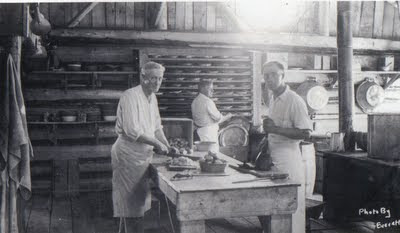"Even though I have undoubtedly missed a great deal in this writing, I must say it has given me considerable pleasure in the memories of it's preparation. " L.T.Falls
THOS. FALLS TIMBER CO. Ltd.
Tom Falls first came to the Thunder Bay area in or about the year 1906.
In 1933, Falls acquired timber lots east of Lake Helen on the C.N.R. The camps were south of Hogarth on the main branch of the Jackfish River. The cut was pulp, which was driven down the river to Lake Superior.
In 1935, new lots were acquired east of Nipigon on the C.P.R. north of Ozone. These camps were for the purpose of taking out spruce and balsam pulp. Also in 1935, ties were again taken from the McKirdy siding at mileage 56 on the C.N.R. The ties were sold to the C.N.R.
IN THE BEGINNING ALL WORK WAS MANUAL.
Ties were made by falling the timber, flattening the sides with the use of a broad axe and then cutting them in either eight foot or sixteen foot lengths. That winter a sawmill was used to square ties instead of hueing in the bush. The timbers were cut into eight foot tie blocks and skidded from the bush on drays pulled by horses. The blocks were piled on a skidway at the mill site. They were then hand levered into the saw carriage to be sawed into square ties.
WHEN HORSE POWER MEANT HORSE POWER
The wood was then hauled from the mill site on heavy sleighs drawn by a team of horses. Depending on the condition of the road and the steepness of the hills, a load could consist of as few as one hundred and twenty or up to two hundred and fifty pieces.
The largest load of ties hauled into the Falls camp was a load drawn by a team of black Percherons, named Niger and Coaly, four hundred and eighty hand hewn ties. The teamster was Jack Bishop.
PULPWOOD
Pulpwood on the other hand, was cut and sawed in generally four or eight foot lengths. Tools for falling and cutting were a bucksaw and an axe. The timber was cut in strip-roads, cut in four or eight foot lengths and then piled in cordage piles.
In those years all hauling was done in the winter. Practically all of it was hauled to the landings, generally situated on a lake or river, where it was poled to await spring break-up when it would be floated out on the spring flood of high water.
ROADS
Minor roads were usually packed snow. Only small loads were hauled on these roads. Whereas the main roads were iced and generally had a very solid foundation. Until the winter of 1939 practically all of Fall's hauling was done by team and sleigh. In the winter of 39-40 we saw our first trucks in camp.
In those times there was no electricity in the camps. Lighting was mostly by Kerosene. In the summer there was no refrigeration. It was truly marvelous how well the meals turned out.
The quality of food was a marvel. Especially considering the supplies were brought to the closest siding by freight train and then loaded on wagons (in the summer) and hauled ten to fifteen miles or more, through swamps, over hills and rocks, into the camp.
 |
| See all the pies on the racks at the back. One lady just loved the fact that her husband never cared for pastries when he came home from camp, she hated to bake. |
The meat house was a pole structured frame enclosed by screen, not bear-proof. The tote teams went daily, rain or shine.








No comments:
Post a Comment